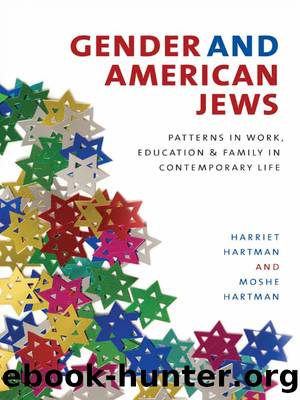Gender and American Jews by Hartman Harriet;Hartman Moshe;Fishman Sylvia Barack;

Author:Hartman, Harriet;Hartman, Moshe;Fishman, Sylvia Barack;
Language: eng
Format: epub
Publisher: Brandeis University Press
a Pub denotes public; Priv, private.
*Significant at p < 0.05; **Significant at p < 0.10.
JEWISH EDUCATION
In this section we explore gender differences in formal Jewish education, and relate these to Jewish identity differences shown in the preceding section. According to the 2000â01 NJPS, more than three-quarters of American Jews report having received Jewish education between the ages of 6 and 17.8 There is a clear gender difference, with more than 80% of men and slightly more than 70% of women reporting having had some formal Jewish education. Most of this education took place before the ninth grade for both men and women, and there is a gender gap at both younger and older levels of Jewish education (Table 6.4). One reason for this gap is most likely that more men received at least some formal Jewish education leading up to their Bar Mitzvah, and because fewer women had a Bat Mitzvah than men had a Bar Mitzvah, there was more impetus for men to receive a Jewish education than women.9
Among those who had some formal Jewish education, men were slightly more likely to have gone to Hebrew school (55.1% compared with 46.5% of women), whereas women were more likely to have attended Sunday School (35.4% compared with 24.0% of men). This may also be because more boys need to learn Hebrew for their Bar Mitzvah.
It is interesting that among those with some formal Jewish education, there is no gender difference in the number of years of education they received (an average of 6.5 years for both men and women; last two rows of Table 6.4). In terms of informal education, men appear to have experienced more sleep-away Jewish camp experience than women, although almost half of both men and women went to a Jewish day camp.10
When we look at gender differences in Jewish education by denomination, we see that there is no gender difference among the Orthodoxâabout 90% of both men and women received formal Jewish education (Table 6.4). But among the Conservative, Reform/Reconstructionist, and unaffiliated, more men received formal Jewish education than women. There is a greater gender difference among the unaffiliated than the Reform/Reconstructionist groups, a greater gender difference among the Reform/Reconstructionist than the Conservative groups, and a greater gender difference among the Conservative than the Orthodox groups. This is reflected by (or stems from) the larger difference by denomination among women than among men. Perhaps the need for training for Bar Mitzvah, more common among boys, narrows the differences between denominations for boys more than for girls.
Among those who had some formal education, there is little gender difference in the length of formal education within any of the denominations. The length of education for both men and women varies by denomination: among the Orthodox, the average length of formal Jewish education is about 9 years; among the Conservative, about 6.8; among Reform/Reconstructionist, 6.1 years; and among the unaffiliated, about 5.9 years.
Table 6.4 Jewish Education of American Jews, by Gender and Denomination
Download
This site does not store any files on its server. We only index and link to content provided by other sites. Please contact the content providers to delete copyright contents if any and email us, we'll remove relevant links or contents immediately.
| Haggadah | Hasidism |
| History | Holidays |
| Jewish Life | Kabbalah & Mysticism |
| Law | Movements |
| Prayerbooks | Sacred Writings |
| Sermons | Theology |
| Women & Judaism |
The Secret Power of Speaking God's Word by Joyce Meyer(2702)
Man's Search for Meaning by Viktor E. Frankl(2533)
Mckeown, Greg - Essentialism: The Disciplined Pursuit of Less by Mckeown Greg(2309)
MOSES THE EGYPTIAN by Jan Assmann(2253)
Devil, The by Almond Philip C(2180)
Unbound by Arlene Stein(2157)
The Complete Dead Sea Scrolls in English (7th Edition) (Penguin Classics) by Geza Vermes(2110)
I Capture the Castle by Dodie Smith(1871)
Schindler's Ark by Thomas Keneally(1744)
The Invisible Wall by Harry Bernstein(1686)
The Gnostic Gospel of St. Thomas by Tau Malachi(1653)
The Bible Doesn't Say That by Dr. Joel M. Hoffman(1594)
The Secret Doctrine of the Kabbalah by Leonora Leet(1513)
Political Theology by Carl Schmitt(1483)
The Jewish State by Theodor Herzl(1457)
A History of the Jews by Max I. Dimont(1417)
The Book of Separation by Tova Mirvis(1410)
The Dead Sea Scrolls Bible by Martin G. Abegg(1402)
Oy!: The Ultimate Book of Jewish Jokes by David Minkoff(1277)
